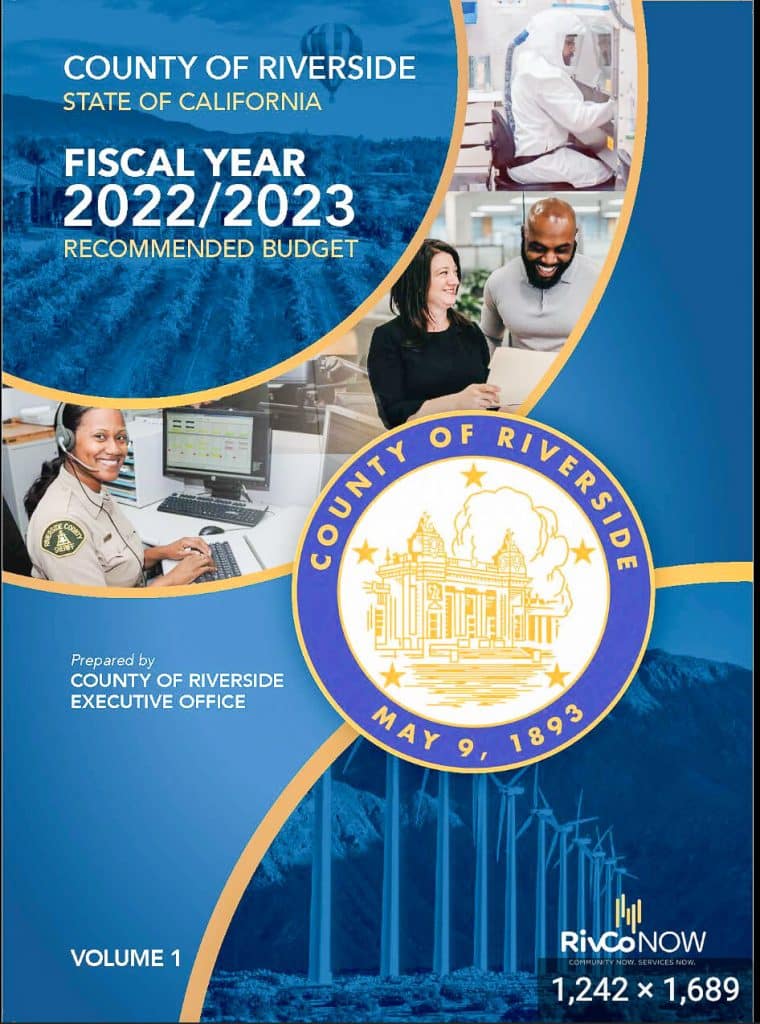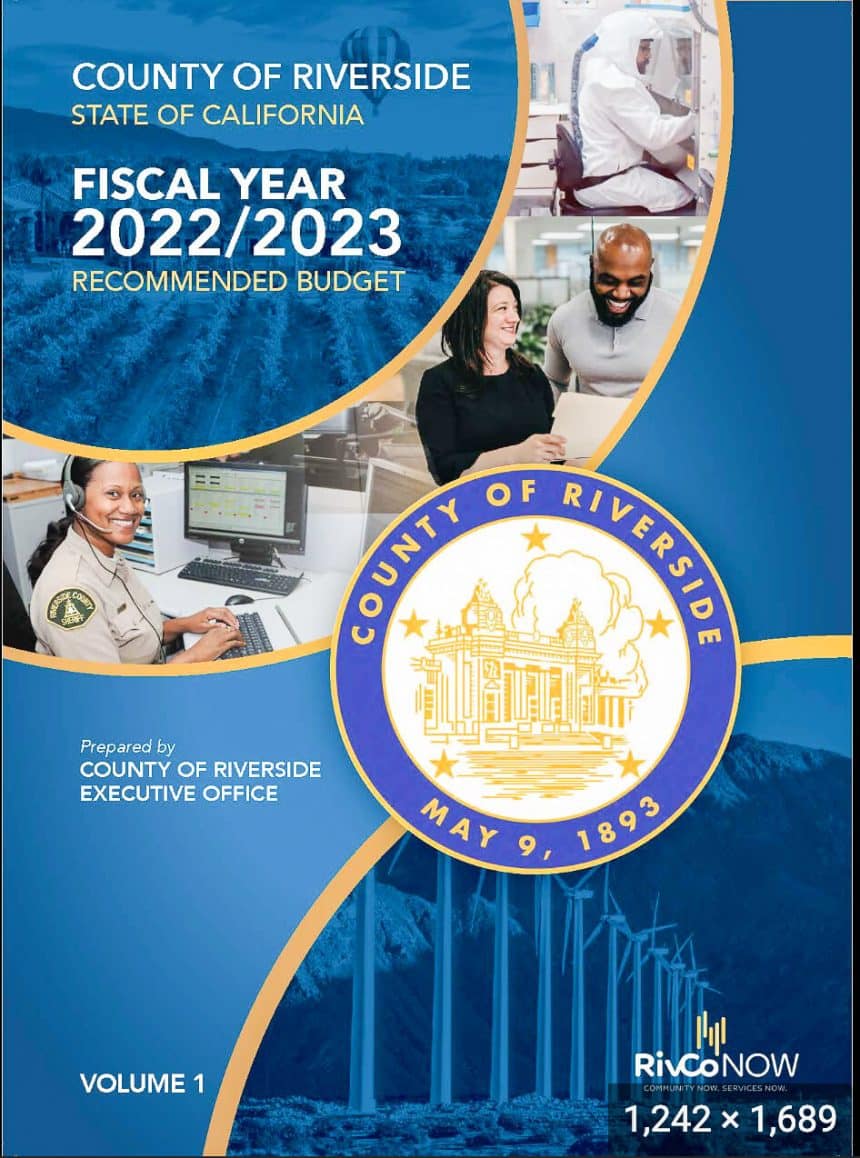RIVERSIDE (CNS) – Riverside County government’s financial position going into the second half of the current fiscal year is better than predicted, with discretionary revenue now on track to beat initial estimates by almost $100 million, though agencies are already seeking more money to sustain operations, officials said Tuesday.
“There are more than $350 million in new funding requests,” county Chief Executive Officer Jeff Van Wagenen told the Board of Supervisors. “We’re going through the process of working with departments to bring forward recommendations on how to pay for their needs.”
Van Wagenen said that the main objective now is to “determine what departments need not to shrink.” He said the goal is to keep agencies “flat” by focusing on “strategic priorities” and not indulging biases toward expansion.
His comments were delivered during a brief presentation on the 2022-23 midyear budget report, which indicated that discretionary revenue will likely exceed initial projections by $89 million by the end of the fiscal year, topping out at $1.102 billion, rather than the $1.013 billion originally projected.
The gains are mostly the result of higher tax receipts, as residents shelled out more for goods and services, as well as greater earnings from the county’s investment pool.
Property tax receipts are expected to expand by $21.5 million more than what officials estimated before, while the county will likely take in $6.2 million in additional sales and use taxes, and separately, the county’s share of statewide Proposition 172 Public Safety Sales Tax revenue is projected to be $13.4 million greater than first estimated, according to the Executive Office.
Interest earnings within the Treasurer-Tax Collector’s investment pool, containing a range of fixed instrument products, are expected to be $35 million to $45 million more than earlier estimated, officials said. The returns stem directly from the Federal Reserve Bank’s ongoing hikes to the benchmark short-term lending rate — pushing interest rates higher on the county’s investments — a process that began last May as part of a liquidity pullback strategy to attack 40-year high inflation.
Board Chairman Kevin Jeffries stressed to Van Wagenen that he will oppose “mission creep” by agencies “wishing to expand … and take on other responsibilities” that saddle the county with unnecessary higher costs.
“A make or break for me (on budget planning for 2023-24) is the sheriff’s level of service (in unincorporated communities),” Jeffries said. “There needs to be a minimum level of acceptable service.”
At midyear, multiple county agencies were contending with higher cost pressures, requiring bigger outlays to deal with them, the Executive Office stated. Most of the budgetary challenges were driven by revised or renewed collective bargaining agreements guaranteeing cost-of-living and merit pay hikes, as well as more county obligations to pay health insurance. However, some of the costs were tied to building maintenance and expansions, officials said.
The Riverside University Health System announced the largest appropriations need at $105.45 million. RUHS runs the only public hospital in the county, and the bulk of patients are at or near the poverty level. The agency said that “increased patient demand” had required “additional staffing and supplies to provide the necessary patient care.” Essentially all of the increased appropriations for what remains of 2022-23 will be covered through federal and state reimbursements, the EO said.
Among public safety agencies, the Fire Department had the largest appropriations request at $8 million. But the lion’s share of the expense will be covered via municipalities’ payments to the department under contracts with the county.
Officials said that the county reserve pool is now projected to be $537 million, compared to $511 million projected in November. The original estimate in June was $368 million.
The board approved a $7.45 billion budget for 2022-23, roughly 8% larger than the 2021-22 budget of $6.88 billion. Most of that money is comprised of non-discretionary, or programmed, budget appropriations and includes “pass-through” revenue streams from the state and federal governments.
The county received almost $500 million in 2020 Coronavirus Aid, Relief & Economic Security Act allocations and another $480 million in 2021 American Rescue Plan Act money, and Van Wagenen acknowledged in June that just under 10% of the federal infusions were being applied to “budget stabilization” in 2022-23.
The funds have been used for homeless and rental assistance programs, along with other social welfare efforts, but they’ve also been appropriated for infrastructure, or capital improvement, projects.
Hearings on the 2023-24 fiscal year budget will be held in June.




You have remarked very interesting points! ps decent site.Raise your business
Can you be more specific about the content of your article? After reading it, I still have some doubts. Hope you can help me.
Your article helped me a lot, is there any more related content? Thanks! https://accounts.binance.com/hu/register-person?ref=FIHEGIZ8
Thank you for your sharing. I am worried that I lack creative ideas. It is your article that makes me full of hope. Thank you. But, I have a question, can you help me?
Your article helped me a lot, is there any more related content? Thanks!
Your point of view caught my eye and was very interesting. Thanks. I have a question for you.
70918248
References:
best steroid substitute [https://www.consultrh.fr/project-details/students-success-stories/]
70918248
References:
Closest Thing To Steroids [http://www.tmstarsllc.com/blog/]
70918248
References:
none – https://marketanna.com/digital-marketing-made-easy-let-our-team-handle/ –
Your article helped me a lot, is there any more related content? Thanks!
I don’t think the title of your article matches the content lol. Just kidding, mainly because I had some doubts after reading the article.
Your point of view caught my eye and was very interesting. Thanks. I have a question for you.